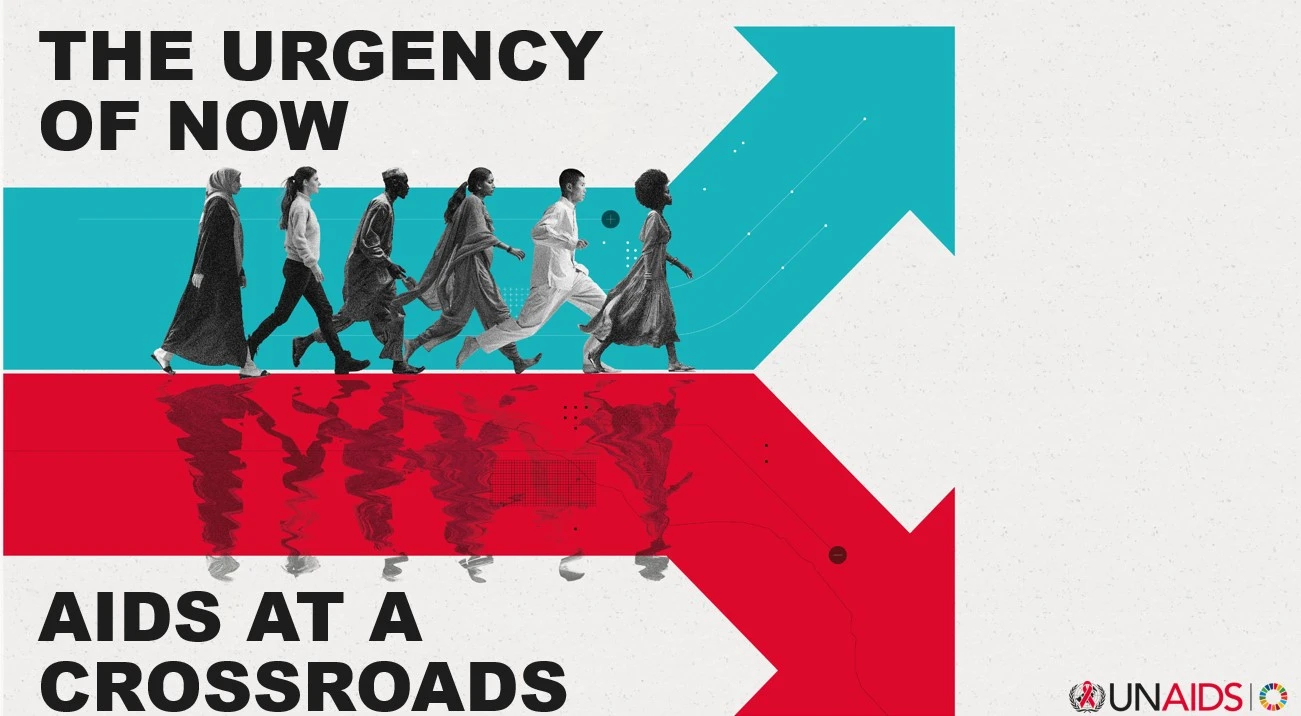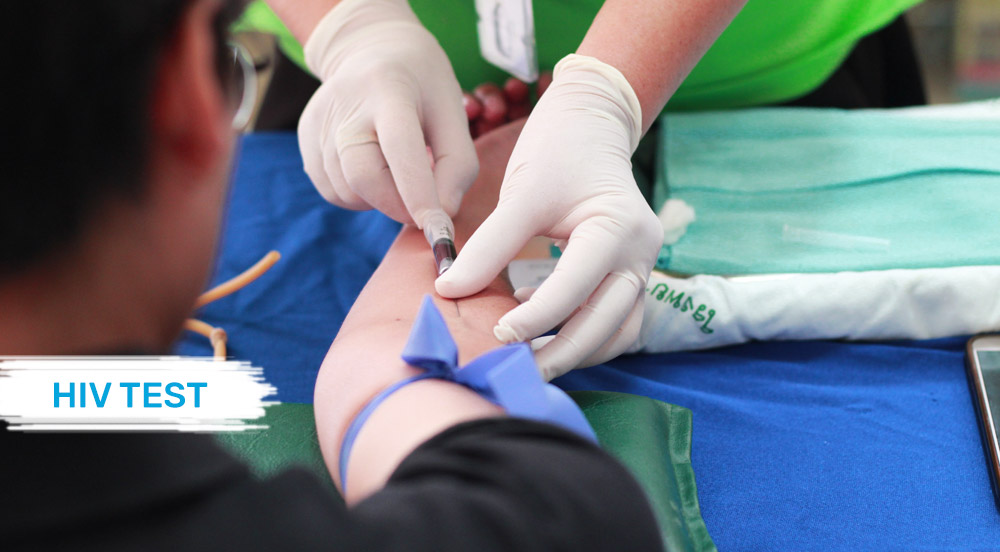Health
UNAIDS Reports Rising HIV infections in Asia-Pacific

GENEVA – UNAIDS has released its 2025 Global AIDS Update, “AIDS, Crisis and the Power to Transform.” The report warns that a serious funding shortage is putting decades of progress at risk unless countries make bold changes in how they run and fund HIV programs.
The report points out that recent major cuts from international donors have had a big impact. Even though 2024 saw progress in fighting HIV, sudden drops in funding have stopped prevention programs and put treatment services in danger.
“This is more than a funding gap, it’s a ticking time bomb,” said Winnie Byanyima, Executive Director of UNAIDS. “We have seen services disappear overnight. Health workers have lost their jobs, and people—especially children and those at higher risk—are losing access to care.” Key populations are groups at a higher risk for HIV, like men who have sex with men, people who inject drugs, people in prisons, sex workers, and transgender people.
While some countries are putting more of their own funds towards the HIV response, global progress cannot rest on domestic budgets alone. The report urges the international community to step up, secure the funding needed, support countries in closing gaps in prevention and treatment, remove legal and social barriers, and strengthen local communities.

Asia-Pacific faces a rising HIV threat.
In 2024, around 6.9 million people in Asia and the Pacific were living with HIV. This region has the second-largest epidemic after Eastern and Southern Africa. AIDS-related deaths have dropped by half since 2010, but 150,000 people still died here last year. One in four new HIV infections worldwide comes from Asia-Pacific. In 2024, the region saw 300,000 new infections. Since 2010, new HIV cases have dropped by only 17%.
Nine countries in this region are among the 32 where new infections have increased since 2010: Fiji (3091%), the Philippines (562%), Afghanistan (187%), Papua New Guinea (84%), Bhutan (67%), Sri Lanka (48%), Timor-Leste (42%), Bangladesh (33%), and Lao PDR (16%).
Pre-exposure prophylaxis (PrEP), a medicine that prevents HIV, reached fewer than 250,000 people in the region in 2024—far from the 8 million target. Not enough people are receiving prevention services tailored to their needs. Only about half of sex workers, a third of men who have sex with men and transgender people, and a fifth of people who inject drugs accessed prevention services last year. Young people from key populations are still highly at risk.
“Our hope to end AIDS as a public health threat in Asia-Pacific by 2030 is now hanging by a thread. Every two minutes, someone new is infected,” said Eamonn Murphy, UNAIDS Regional Director for Asia Pacific and Eastern Europe, Central Asia. He called on governments and the global community to fund prevention, treatment, PrEP, and new long-acting medicines.
Fiji saw HIV diagnoses triple in 2024 compared to the previous year, and early figures show that half of those on antiretroviral therapy likely caught HIV from injecting drugs. The report highlights Fiji’s urgent need for harm reduction services. It also describes how US funding cuts in the Philippines have left a gap in prevention programs for young people at risk, especially young men who have sex with men.

UNAIDS HIV testing and treatment need more support
In 2024, 79% of people living with HIV in Asia-Pacific knew their status. Just 69% were on treatment, and 66% had a suppressed viral load. A quarter of people worldwide who are not getting HIV treatment live in this region. In 2024, less than half of the people with HIV in Afghanistan, Bangladesh, Fiji, Indonesia, Mongolia, Pakistan, Papua New Guinea, and the Philippines received antiretroviral therapy.
“There is a crisis for those who can’t get HIV services or are too scared to seek them,” said Harry Prabowo, Coordinator for APN+, the Asia Pacific Network of People Living with HIV. “Our region needs to do more to help those who are left out of care and community support.”
Even with these hurdles, the report gives credit to several countries for their progress. Nepal is one of just five countries worldwide that cut new HIV infections by over 75% since 2010. Cambodia treats nearly all who are diagnosed, with more than 98% of treated people achieving viral suppression in 2024. Australia is close to reaching the “95-95-95” targets for testing, treatment, and suppressed viral load.
Thailand now funds more than 90% of its HIV response from its budget. Bhutan, Pakistan, Timor-Leste, and Thailand are set to increase their domestic HIV funding in 2026. Indonesia grew its domestic HIV spending more than four times between 2010 and 2022. Yet, across the region, only half the resources needed for the HIV response are currently available.
Related Health News:
Insights and Tips for Robust Health and Vitality
Health
Clogged ‘Drains’ in the Brain Could Be Early Alzheimer’s Warning Signs

SINGAPORE – “Drains” in the brain that clear away toxic waste appear to get blocked in people who show early signs of Alzheimer’s disease, according to new research from Nanyang Technological University, Singapore (NTU Singapore).
These blocked brain drains, known as enlarged perivascular spaces, seem to act as an early warning sign for Alzheimer’s, which is the most common type of dementia.
Associate Professor Nagaendran Kandiah from NTU’s Lee Kong Chian School of Medicine (LKCMedicine), who led the study, explained that these changes can be picked up on routine MRI (magnetic resonance imaging) brain scans used to investigate memory or thinking problems. Because of this, spotting enlarged perivascular spaces could support current methods of detecting Alzheimer’s at an earlier stage, without needing extra tests that cost more time and money.
Justin Ong, a fifth-year LKCMedicine student and the study’s first author, shared that early detection of Alzheimer’s helps doctors act sooner to slow worsening symptoms. These symptoms include memory loss, slower thinking, reduced concentration, and changes in mood or behaviour. The project was carried out as part of LKCMedicine’s Scholarly Project module in the Bachelor of Medicine and Bachelor of Surgery programme.
The work also stands out because it focuses on Asian participants. Most dementia studies so far have centred on Caucasian groups. In this research, the team studied almost 1,000 people in Singapore, across ethnic groups that reflect the local population. They compared people with normal cognitive function and those with mild thinking or memory problems.
Research on Asian populations is important because past studies suggest that dementia can present differently in different ethnic groups.
Assoc Prof Kandiah, who also serves as Director of the Dementia Research Centre (Singapore) at LKCMedicine, pointed out one example. Among Caucasian patients with dementia, past data show that between 50 and 60 per cent have a major risk gene, apolipoprotein E4, which is linked to Alzheimer’s.
In contrast, less than 20 per cent of dementia patients in Singapore carry this gene. This means that patterns seen in Caucasian patients might not apply directly to Asian patients, and the reverse is also true.
Spotting Alzheimer’s before symptoms worsen
Blood vessels in the brain sit within small fluid-filled gaps called perivascular spaces. These spaces act like channels that allow toxic waste products to drain away. These waste products include beta amyloid and tau proteins, which build up in large amounts in the brains of people with Alzheimer’s disease.
When this waste clearance system does not work properly, the perivascular spaces can become clogged and enlarge. These enlarged perivascular spaces are visible on MRI scans. Until now, it was not clear how strongly this condition was linked to dementia, especially Alzheimer’s disease.
The NTU team set out to improve on earlier studies by comparing these blocked brain drains with a wider set of biological signs of Alzheimer’s. They examined how enlarged perivascular spaces matched up with key Alzheimer’s markers, such as beta amyloid protein build-up and damage to the brain’s white matter. White matter is the network of nerve fibres that connects different brain regions and helps them communicate.
The researchers studied close to 1,000 people in Singapore. Around 350 participants had no cognitive problems, meaning their thinking, memory, decision making, and focus were normal.
The remaining participants had mild cognitive issues that may signal the early stages of disease, including mild cognitive impairment. Mild cognitive impairment is a recognised stage that comes before full-blown dementia. Past research shows that people with mild cognitive impairment have a higher chance of later developing conditions such as Alzheimer’s disease and vascular dementia, a type of dementia caused by reduced blood flow in the brain.
For this study, the team reviewed MRI scans from all participants. They found that people with mild cognitive impairment were more likely to have enlarged perivascular spaces, in other words, clogged brain drains, compared with those who had no cognitive problems.
The scientists also measured seven blood markers linked to Alzheimer’s, including levels of beta amyloid and tau proteins. Raised levels of these markers are a sign that Alzheimer’s disease may be present or developing.
They discovered that enlarged perivascular spaces were associated with four out of the seven blood markers. This means people with clogged brain drains tend to have more amyloid plaques, tau tangles, and brain cell damage. As a result, they appear to face a higher risk of going on to develop Alzheimer’s disease.
The team then looked at white matter damage, which doctors already view as a key marker of Alzheimer’s. They checked how strongly white matter changes were related to the same seven blood markers and found links with six of them. However, there was an interesting twist.
When they compared white matter damage with enlarged perivascular spaces, they found that, in people with mild cognitive impairment, the link between the blood markers and enlarged perivascular spaces was even stronger than with white matter damage. This pattern suggests that clogged brain drains may show up earlier in the disease process than white matter damage.
If doctors can use this information in practice, they may be able to act earlier, slow disease progression, and reduce the chance of permanent brain injury.
Assoc Prof Kandiah said the results have “substantial clinical implications”. White matter changes are currently more widely used to assess dementia because doctors can spot them easily on MRI scans. However, the study suggests that enlarged perivascular spaces may offer unique value in identifying early signs of Alzheimer’s disease.
What other experts say
Dr Rachel Cheong Chin Yee, Senior Consultant and Deputy Head at Khoo Teck Puat Hospital’s Department of Geriatric Medicine, who was not involved in the study, explained that the research highlights the role of small blood vessels in the brain. In this case, the enlarged perivascular spaces around blood vessels, which help clear waste, may play a part in the development of Alzheimer’s disease.
She added that the findings are important because they suggest that MRI scans showing enlarged perivascular spaces could help pick out people at higher risk of Alzheimer’s, even before clear symptoms appear.
Dr Chong Yao Feng, a Consultant in the Division of Neurology at the National University Hospital and Clinical Assistant Professor at the National University of Singapore’s Yong Loo Lin School of Medicine, also commented on the study. He noted that cerebrovascular diseases, which affect the blood vessels of the brain, and Alzheimer’s disease have long been viewed as separate conditions with different underlying processes.
He described the results as intriguing because they show that these two conditions may interact and worsen each other, instead of acting in isolation.
In practical terms, this means that when a doctor orders an MRI scan to explore a patient’s memory or thinking concerns, and the scan reveals markers of cerebrovascular disease such as enlarged perivascular spaces, the doctor should not simply assume that blood vessel problems are the only cause of the symptoms. The presence of such markers may also point to a higher risk of Alzheimer’s disease.
Dr Chong said that doctors will need to weigh the scan findings together with the patient’s symptoms, medical history, and concerns. They may then discuss with the patient whether further tests are needed to confirm or exclude Alzheimer’s disease.
What comes next
The NTU research team plans to continue tracking the same group of participants to see how many eventually go on to develop Alzheimer’s dementia. This long-term follow-up will help confirm whether enlarged perivascular spaces can reliably predict which people with clogged brain drains are more likely to progress to dementia.
If more studies in different countries and populations support this link between clogged brain drains and Alzheimer’s, the presence of enlarged perivascular spaces on MRI scans could become part of routine assessment. In time, this could give clinicians another useful tool to identify people at risk of Alzheimer’s disease much earlier in the course of illness, when treatment has the best chance of slowing decline.
About Nanyang Technological University, Singapore
A research-intensive public university, Nanyang Technological University, Singapore (NTU Singapore) has 35,000 undergraduate and postgraduate students in the Business, Computing & Data Science, Engineering, Humanities, Arts, & Social Sciences, Medicine, Science, and Graduate colleges.
NTU is also home to world-renowned autonomous institutes – the National Institute of Education, S Rajaratnam School of International Studies, and Singapore Centre for Environmental Life Sciences Engineering – and various leading research centres such as the Earth Observatory of Singapore, Nanyang Environment & Water Research Institute, and Energy Research Institute @ NTU (ERI@N).
Under the NTU Smart Campus vision, the University harnesses the power of digital technology and tech-enabled solutions to support better learning and living experiences, the discovery of new knowledge, and the sustainability of resources.
Ranked amongst the world’s top universities, the University’s main campus is also frequently listed among the world’s most beautiful. Known for its sustainability, NTU has achieved 100% Green Mark Platinum certification for all its eligible building projects. Apart from its main campus, NTU also has a medical campus in Novena, Singapore’s healthcare district.
For more information, visit www.ntu.edu.sg
Related News:
UnitedHealth Is Under Federal Investigation and Cooperating With Authorities
Health
NYC Legionnaires’ Outbreak Reaches 90 Cases; 3 Deaths Are Reported

(VOR News) – According to the New York City Department of Health, 90 people have been ill and three have died from Legionnaires’ disease in Central Harlem. The authorities made the declaration.
In recent days, the city’s health office has suggested stricter guidelines for assessing building-based cooling towers. The towers in question are suspected of being the origin of the outbreak.
Just before Legionnaires became effective, the proposal was made.
Buildings can be cooled thanks to cooling towers, which are enormous devices that are placed on rooftops and release mist into the surrounding air. Mist is dispersed around the area by these towers. Using cooling towers is standard procedure in the building industry.
Legionella bacteria can grow in the tower if the water is not well cleaned or if it is excessively hot. By breathing in this filthy mist, people expose themselves to the risk of getting sick. This exposes them to the risk of being ill.
According to a Department of Health spokeswoman who talked to CNN, the new law “was in development well before the Legionnaires’ cluster in Central Harlem.” This information was obtained by CNN. CNN was successful in obtaining this information.
Building owners must register and maintain their cooling towers, which are inspected on a regular basis, according to CNN. Inspections of cooling towers are also possible. Cooling towers can also be inspected on their own initiative. Building owners are required by the current state law to provide this information to the authorities in charge of gathering it.
The proposal under consideration stipulates strict testing schedules, state-certified laboratories to analyze samples, and penalties for noncompliance.
As of right now, there is no information available on the financial penalty. Currently, there are fines ranging from $500 to $2,000 each instance for noncompliance with the maintenance requirements. These penalties may be applied to each case separately.
However, it is probable that significant issues may arise during the enforcement process. Inspections have significantly decreased, with fewer than half as many in 2024 as in 2017, when the city started keeping track of them, according to Gothamist, a non-profit journal affiliated with WNYC public radio.
Gothamist supplied this information. There is a significant discrepancy between these figures and the 2017 inspections. The city developed these specifics based on the data it had collected.
July 25th saw the city announce the Legionnaires cluster
Following an assessment of all operational cooling towers in the area, health department officials cleaned any cooling towers in the impacted area that contained Legionella. The authorities were the ones that supplied this information.
In the United States of America, the Centers for Disease Control and Prevention (CDC) has determined that pneumonia is actually a subtype of legionnaires’ disease. The CDC created this classification system.
You may experience a number of symptoms, such as coughing, fever, headaches, muscle problems, and shortness of breath, among others. You run the danger of experiencing a number of symptoms. Additionally, shortness of breath is another symptom that may be present.
The suggested plan of action for treating the illness is to utilize antibiotics. If you decide to ignore it, you could end up with serious issues like lung failure or even death. These issues might be avoided with the help of the treatment.
The data presented by the Occupational Safety and Health Administration (OSHA) suggests that there are roughly 6,000 reported incidents that occur in the United States of America each year.
According to those working in the medical field, the true figure is much greater than what is typically believed to be true. One of the factors contributing to this misperception is the difficulty in distinguishing between various forms of pneumonia, such as Legionnaires’ disease and other forms of pneumonia.
SOURCE: ME
SEE ALSO:
Preliminary Studies Show Eli Lilly’s Weight Loss Medication Is Promising
How to Understand Legionnaires’ Disease, Which Has Sickened Scores in NYC.
Health
Preliminary Studies Show Eli Lilly’s Weight Loss Medication Is Promising

(VOR News) – A recent study suggests that Eli Lilly’s new weight-loss medication helped individuals lose significant amounts of weight.
Patients were capable of losing an average of 27.3 pounds, which is equivalent to 12.4% of their total body weight, when they were administered the highest dose of orforglipron for 72 weeks.
Eli Lilly intends to submit an application to the Food and Drug Administration (FDA) of the United States of America requesting authorization to commercialize the medication before the end of the year.
Wegovy, Ozempic, Zepbound, and Mounjaro are Eli Lilly injectable medicines that are used to treat type 2 diabetes and obesity. If approved, the tablet could provide a simpler alternative to injection-based substances like the medications under consideration.
In an interview with The New York Times, Kenneth Custer, president of cardiometabolic health at Eli Lilly, stated that tablets are more straightforward to manufacture and can be produced on a large scale.
“The number of individuals we can assist has increased by orders of magnitude,” he stated, adding that pills may also be beneficial to those residing in countries that lack cold storage, which is essential for the delivery of intravenous medications.
The novel GLP-1 medicine is also similar to injectable therapy.
According to the Cleveland Clinic, GLP-1 medications function by causing patients to feel fuller for an extended period of time and by slowing down the rate at which they eat.
In the most recent clinical trial, 3,127 individuals were randomly assigned to receive either forglipron or a placebo. Three distinct concentrations were implemented to evaluate the efficacy of the medication.
In addition to a decrease in their overall body weight, individuals who consumed the medication experienced enhancements in their cholesterol, triglyceride, and blood pressure levels.
The Times reported that many of the recorded adverse effects were similar to those previously documented with injectable medications. These adverse effects included indigestion, constipation, diarrhea, and vomiting.
Additionally, Lilly conducted a study earlier this year to assess orforglipron in individuals with type 2 diabetes. They found that it produced advantages that were comparable to those of Ozempic in terms of weight loss and blood sugar reduction.
The Times reports that the business plans to make the pharmaceutical available for the treatment of diabetes in 2026, following the receipt of authorization from the FDA. At present, there is no direct comparison between the efficacy of orforglipron and injectable medications like Zepbound or Wegovy.
In a previous study, participants who utilized Zepbound experienced a 20.2% reduction in body weight over a 72-week period, while those who utilized Wegovy experienced a 13.2% reduction in body weight during the same time frame.
However, Eli Lilly experts believe the novel treatment may have numerous benefits.
Because of this, Dr. David Cummings, an obesity expert at the University of Washington in Seattle, posits that it may not be as beneficial as injections.
On the other hand, Cummings observes that “that feature alone could make it truly impactful” if it were to become significantly less expensive and simpler to manufacture.
Eli Lilly has not yet disclosed the price of the medication; however, the company intends to do so following the Food and Drug Administration’s (FDA) review of the drug in anticipation of its marketing approval.
It is estimated that 170 million individuals in the United States could potentially benefit from the use of pharmaceuticals for obesity, although Eli Lilly only approximately 8 million individuals are currently taking these medications.
He stated in an article published in The Times that the high cost and protracted production process associated with the production of injectable medications are among the primary causes.
Custer noted that tablets are more straightforward to manufacture and store, which suggests that this new treatment could potentially benefit a larger population.
SOURCE: USN
SEE ALSO:
How to Understand Legionnaires’ Disease, Which Has Sickened Scores in NYC.
The sniffles? Discover How COVID-19, Summer Colds, And More Can Affect You
-

 News1 month ago
News1 month agoPeace Prize Awared to Venezuela’s María Corina Machado
-

 Politics1 month ago
Politics1 month agoFar Left Socialist Democrats Have Taken Control of the Entire Party
-

 Politics1 month ago
Politics1 month agoHistorian Victor Davis Hanson Talks on Trump’s Vision for a Safer America
-

 News2 months ago
News2 months agoSouth Africa’s Audacious Bid to Teach America a Lesson
-

 Politics1 month ago
Politics1 month agoThe Democratic Party’s Leadership Vacuum Fuels Chaos and Exodus
-

 Politics1 month ago
Politics1 month agoDemocrats Fascist and Nazi Rhetoric Just Isn’t Resognating With Voters
-

 Politics1 month ago
Politics1 month agoChicago’s Mayor Puts Partisan Poison Over People’s Safety as Trump Troops Roll In
-

 News1 month ago
News1 month agoThe Radical Left’s Courtship of Islam is a Road to Self-Defeat





















